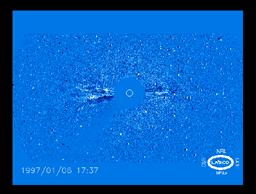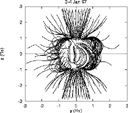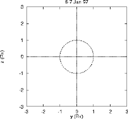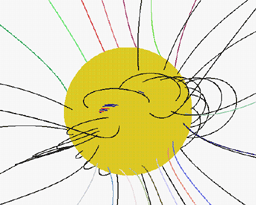 |
Reconstruction of the
Solar/Interplanetary Disturbances for the Space Weather Event on
6-10 Jan 1997

- SOHO's LASCO coronagraph
provided this picture of the
expanding halo of bright material
on 6-7 Jan 97, widely
interpreted as a coronal mass
ejection. The expanding halo's
apparent speed is ~100-150
km/s as projected on the plane
of the sky, but the associated
interplanetary disturbance's
arrival time at Earth indicates the
ejecta attained an ultimate speed
of at least ~450-490 km/s. (This
image is from the Goddard
Space Flight Center ISTP
events web site. The halo was
made visible by differencing
sequential LASCO C3
coronagraph images.) Click on the
image on the right to see the corresponding
animation.
|

|

- Potential field source surface
model reconstructions of the
coronal magnetic field for the 5
days centered on the day of the
6 Jan 97 coronal transient,
constructed from daily updates
of Wilcox Observatory synoptic
maps, show modest changes in
the large-scale coronal field.
However, a part of the coronal
magnetic field containing
substantial flux becomes newly
open on the day of the event
(right panel), perhaps in
response to the photospheric
flux emergence also causing the
filament disruption. Click on the
two images on the right to see the corresponding
animation.
|


|

- The time-dependent version of
the MHD coronal model using
~96 min. resolution MDI data as
a photospheric boundary
condition can determine whether
the observed changes in the
magnetic field on 6-7 Jan 97
explain the observed coronal
transient and subsequent
interplanetary disturbance. The
projected density structure of
the ejection from the model can
be compared with the LASCO
halo images to examine their
comparative coronal behavior.
Click on the
image on the right to see the corresponding
animation.
|

|
PREVIOUS
NEXT
|

